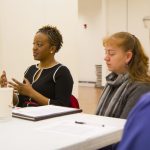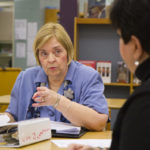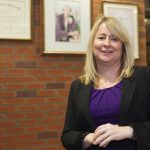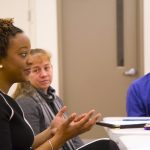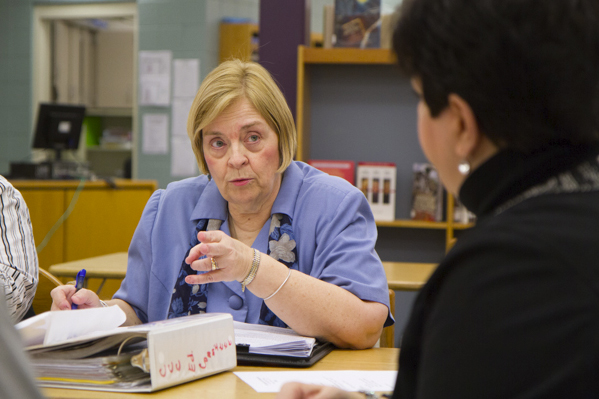
Educational standouts at Science and Technology Academy
Educational standouts at Science and Technology Academy
In 2005, Samuel K. Franklin had been a sixth-grade math and science teacher in Oakland, California, for a mere three years when he decided to move here to attend the Heinz College at Carnegie Mellon University. Since then, he has turned his Heinz thesis into a working Science and Technology Academy within Pittsburgh Public Schools (PPS) and quickly came to head the district’s Office of Teacher Effectiveness.
“I didn’t know much about Pittsburgh and I didn’t know what to expect,” Franklin says. “I certainly didn’t expect to be here seven years later.”
Franklin is just one of the many Pittsburghers — new transplants and lifetime residents — who are changing the face of education in the city.
“The Science and Technology Academy, the fact that it was possible, is testament to what can happen here in Pittsburgh,” Franklin says.
Working closely with Pittsburgh Public Schools
He worked with ten other grad students and community partners on the Academy, hoping for a chance for real-world community impact. They met with then-PPS Superintendent Mark Roosevelt at a time when the district had already begun closing schools, laying off teachers and changing principal leadership and the curriculum. The school was intended to take any student and prepare him or her for advanced STEM (science, technology, engineering and math) courses. Members of Franklin’s team visited other districts nationwide and saw what elements helped them direct their students toward college or career success.
“There was no downside for the district, but for us it was an awesome opportunity,” Franklin recalls. Today, the Academy is about to graduate its first class.
“One of the things I learned,” he says, “is that we planned and planned and researched and visited schools and we put together this very intricate school schedule designed to provide each student the time and support they needed, including an exploration of the field of science and engineering the student was interested in. But at the end of the day it’s all about the teachers and administrators in the building and the quality of teaching that goes on.”
Through his work with the Office of Teacher Effectiveness today, Franklin is overseeing the current teacher evaluation process that replaced previous methods that both the administration and the teacher’s union deemed unhelpful and not reflective of what was true about teaching. The current system, Franklin says, combines peer feedback based on an agreed-upon rubric as well as in-class observation and student surveys.
“We now have the ability to understand and respond in meaningful ways to teaching in our schools, by looking at teachers through multiple lenses,” he says. How the district uses this information, of course, is the critical factor. “The hard work,” he concludes, “is in front of us.”
The vision for nonviolence
Alicia Chico began as a social worker with the Allegheny Intermediate Unit in 2005. In November, 2011, several Mon Valley school districts were attempting to cope with the bad effects of local shootings.
“Nobody was doing anything that was uniform,” Chico noticed. “Why aren’t we all getting together and doing something that will make a difference for the kids?”
Chico brought several districts together — Duquesne, West Mifflin, Clairton, East Allegheny and others — beginning in February 2012 to brainstorm ideas for promoting nonviolence, and to identify stressors that triggered violence.
Today, the group includes representatives from juvenile and adult probation, Penn State’s Evidence-based Prevention and Intervention Support Center, local law enforcement, Big Brothers Big Sisters, the Pittsburgh Initiative to Reduce Crime, and representatives from the county sheriff’s Pittsburgh mayor’s office.
“It’s somewhat frustrating, since it’s so political and there are so many administrative things to do,” says Chico. “Feeling like you’ve accomplished something is difficult.” Still, the group has increased communication in the area, pooling resources and knowledge about risk factors and what can be done to protect these communities.
“My vision has always been to come up with a program where we’re actually working with the kids,” says Chico — not just about violence prevention but about drugs and alcohol, and about giving victims of violence skills to work and get back to the community. “That’s a very, very long-term goal, but that’s the vision.”
From teacher to activist to school board candidate
Cindy Falls was a health-technology instructor in Pittsburgh Public Schools for 18 years at Oliver and Carrick high schools, retiring two years ago. But it seems as if she’s never been more active in schools surrounding Overbrook, where she lives.
“People say to me all the time, ‘Do you know what retirement is?’ says Falls. “I say, I retired from my job. I didn’t retire from trying to help kids. I didn’t retire from trying to help my community.”
Falls is on the board, and is the education chair, for both the Carrick and Overbrook Community Councils. She travels to the PSCCs (Parent School Community Councils) of Concord, Roosevelt, Southbrook and Carrick schools each month, trying to make sure each school and each community knows what the other is doing and gets involved.
She also has been involved with A+ Schools, a nonprofit focused on creating educational equity for PPS students, since the organization’s creation. Last year, she was employed by them as a get-out-the-vote campaign manager for PPS school board district 6, traipsing across Brookline, Beechview, Mt. Washington and the West End from spring to the November election.
“When people would say to me, ‘I don’t have any more kids in school,’ I said, ‘Give me a blank check and I’ll fill it in, because if you don’t care about these issues, that’s what you’re doing with your tax money,'” which funds the school board.
“I honestly consider all of my students my kids,” she says, holding up a dog tag she wears with the picture of a former student in his military dress blues. He is now in Afghanistan.
“He wasn’t in a good place,” she says, when he first came to Falls’ attention. “His remark to me was, ‘Nobody from my family graduated from high school. I don’t really care.’ My remark was, well, that’s not going to happen on my watch.” She brought his grade up in her class but found he wasn’t getting to school early enough to pass other classes. So she began picking him up at home in the morning. He made it to graduation.
Now she has a chance to make an even bigger impact on more kid. She will file on February 12 to run for the district 7 school board seat, from which Jean Fink is retiring. “She’s actually mentoring me, which is fabulous,” Falls says. “I’m so excited about it, I would like to just start tomorrow. But I know it doesn’t work like that.”
Equity and empowerment
The Pittsburgh school district has three goals, says Jeannine French, deputy superintendent in the Office of School Performance: to accelerate student achievement, eliminate racial disparity and become a district of first choice.
Part of the work toward realizing those goals, she says, is creating more teachers who are leaders and increasing their professional development opportunities.
Teachers can now apply to become clinical resident instructors: model teachers or experts in content, who work with other teachers. Institutional teacher leaders support professional growth, doing observations and conferring.
Establishing equity among schools and students may be a harder proposition, but it is central to what has been a financial restructuring of the district from the beginning.
For example, she says, “We have been forthcoming in the fact that we still have disparities, such as disparities in suspensions.” By monitoring suspensions today, they have been reduced 40 percent overall compared to this time last year. In particular, African American boys have been suspended 2,000 fewer days than they were by this time last year, French says. Schools are taking a variety of approaches — reducing misbehavior, reducing the variety of things judged as misbehavior (such as being in the hall at inappropriate times) and finding alternatives to suspensions. Similarly, the racial gap in gifted program referrals and AP course enrollment has been closing as well.
“Equity doesn’t always mean equal,” French says. Instead, it’s a matter of solving the conundrum, “How do you accelerate achievement for children who have been historically underserved.”
Working herself out of a job
Sandy Finkel, supervisor of the Allegheny Intermediate Unit’s blind and visually impaired support program, helps a team of 25 teachers travel among 40 school districts, serving more than 200 Allegheny County kids with vision deficits. They range from three to 21 years old, and from having low vision to being totally blind. About 60 of those students need help from a variety of assistive technologies.
“Technology for people who are blind or visually impaired has been evolving for the last 15 years, so it is still relatively new,” Finkel notes.
Aided by the AIU’s full-time assistive technology specialist Brenda Loughrey, Finkel’s office evaluates the latest software and devices, trains the teachers on their use and supports them as they implement the technology in their classrooms.
“The changes in technology are happening minute by minute,” she says, but technology also lets her staff show teachers how to repair balky equipment (via Skype) and provides remotely linked staff development every month.
The biggest tech buzz currently centers around the iPad, since it has built-in accessibility tools that speak what’s on the screen and increase the size of on-screen materials. “And iPads are accepted and used by typical children,” she says, “so there are a lot of features that make them acceptable and used by [our] children and their parents.
“We try to work ourselves out of a job,” she adds. “While the student is young there is a lot of assistance, but as they get older they adapt a lot of the materials and advocate for themselves. Our goal is for them to become as independent as possible.”
Re-creating a school from the ground up
“Every time I hear people talk about urban students it’s always in a negative way, and it’s always about their deficits,” says LouAnn Zwieryznski, principal of Pittsburgh Faison K-5 in Homewood. The students in urban schools, she says, “come to us with gifts. They come to us with such resilience.” Some are first and second graders taking care of younger siblings at home while parents are at work. “That child has adult responsibilities and he’s extremely intelligent but that’s not always captured on a writing test.” How do we as a society celebrate and support students equitably?
And how do we support teachers? “Teachers should be celebrated. They take so much public heat in a negative way. Teachers who work in schools with high needs should be celebrated on a regular basis.”
For that matter, how do we fund schools equitably? Don’t the best teachers and most money belong with the neediest kids, she asks.
Zwieryznski’s school “was purposely put here to build the culture of the community,” she notes. However, “the test scores at Faison have never been good, since the building opened.”
Closed after fewer than seven years in operation, the school was re-opened with 80 percent new staff and Zwieryznski at the helm two years ago.
“It was reopened with the vision of being a 90/90/90 school,” she says, with 90 percent of the students eligible for free or reduced-cost lunches, 90 percent minorities and 90 percent earning a proficient or advanced mark in the state’s standardized tests for math and reading.
“Last year was our planning year,” she says. “This is year is our implementation.”
Part of the Faison playbook, as Zwieryznski calls the school plan, is to teach subjects more deeply than broadly, and to implement its school-wide positive behavior support, called ROAR for “Respectful, On task, Appropriate, Responsible.” Students can ascend levels from “Positives” and “Leaders” all the way up to “Executives.” Students become “Concerns” when they are not attending school, completing homework or being polite. They are moved up and down publicly in weekly assemblies.
“They really get into their status and getting promoted and their parents appreciate it,” she says.
“We’re a community. How can we help each other to improve? That has really made a difference in the school here.”
The school has been careful to connect to the surrounding community too, partnering with East End Cooperative Ministry, Homewood Children’s Village, the Office of Early Childhood Development at Pitt and many others. Several retired teachers are volunteers in the building, and Indiana University of Pennsylvania student teachers are spending the entire year there — not just the single semester usually required of student teachers — and even taking their classes from IUP professors at Faison.
“So we have a core of community leaders who are dedicated to working here,” Zwieryznski says.
The school is also emphasizing the use of data for assessing and making decisions. Every day, every teacher posts attendance and uniform compliance figures. More importantly, they assess and identify students who need support. In kindergarten, teachers make individual plans for each student who hasn’t yet mastered certain language skills.
“That’s what we want to get to at all grade levels,” she says. “But we have so much further to go.”
Foundation for improvement
Melanie Brown is helping to lead the new educational strategy of the Heinz Endowments, conceived in 2010 and just now beginning to translate into programs on the ground, with $500,000 in funding going to four grantees. Now a program officer in the education program, Brown is a former middle- and high-school teacher in a Washington, D.C. charter school who was disappointed in not seeing enough youth, parent and teacher engagement and empowerment there.
“The strategy for the education program is focused on achieving equity in schools for African American students and low-income students, regardless of their race” in Allegheny County, she says. Equity means that “every person in these school environments has access to quality education resources, effective teachers and supports that fill the gaps in education … and they have a lot of choices.”
Historically, she says, some youth in school were being over-criminalized and thrown into “drop-out factories.” The Endowments believes instead that all young people can be trained to become advocates for changing their own lives. “Youth organizing for school change” is thus the theme of the Endowment’s current efforts. Included among funders are organizations giving voice to youth concerns, such as CMU’s Hear Me project and the Youth Media Advocacy Project at Carlow University, which both record student opinions and teach them how to create media and push for their views to be heard by the public and those in position to help.
“Young people are not just problems. They are problem solvers,” Brown says. And they are aware of inequity. “They recognize it. They don’t always have the speech to acknowledge it or the skills to address it. The idea is that young people in these organizations will be receiving training to really understand how you go about bringing about change the right way.”
The issues around which the students are organizing are not traditional issues, such as getting a salad bar for the cafeteria. Youth leaders in other states have gotten laws changed and improved school discipline practices and graduation rates, Brown reports. “We’ve seen those issues across the country. It is possible to do such a thing here in Pittsburgh.” The Endowments’ new effort also grows out of its own Heinz Endowments Summer Youth Philanthropy Internship Program, which brings in students between high school and college, teams them with a local nonprofit agency and educates them on how to be effective philanthropists.
Parent engagement is just as important, she adds. “Young people don’t just show up at school — they come from families. We need to make parents feel empowered at their schools. You really need people from all sides pushing to bring about changes in education for kids.”
From top to bottom: Cindy Falls, LouAnn Zwieryznski, Melanie Brown.
Photographs by John Altdorfer.
